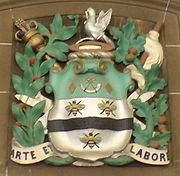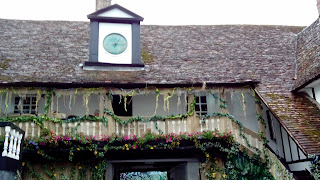Today, 1st November, is traditionally All Hallow's Day, now more commonly known as All Saints' Day. Like many landmarks of the medieval year, it is mentioned in the Sir Gawain and the Green Knight poem (so many feastdays are mentioned in the poem that it functions almost as a calendar or guide to the medieval year).
Earlier I posted about Michaelmas Day, which heralds the onset of winter and reminds Gawain that he must leave the safety of Arthur's court and set out on his quest for the Green Knight (see my post
here). However, Gawain procrastinates (well, who wouldn't, in his situation!) and does not leave Camelot until early November. On All Saints' Day Arthur provides in Gawain's honour a large and hearty feast, and, after much prolonged leave-taking, the knight leaves the next morning:
Yet quyl Al-hal-day with Arther he lenges,
And he made a fare on that fest, for the frekes sake,
With much revel and ryche of the Rounde Table.
Knyghts ful cortays and comlich ladies,
Al for luf of that lede in longynge thay were;
Bot never-the-lece ne the later thay nevened bot merthe,
Mony joyles for that jentyle japes ther maden.
For aftter mete with mournyng he meles to his eme,
And spekes of his passage, and pertly he sayde:
'Now, lege lorde of my lyf, leve I you ask.
Ye knowe the cost of this cace, kepe I ni more
To telle yow tenes therof, never bot trifel;
Bot I am boun to the bur barely to-morne,
To sech the gome of the grene, as God wyl me wisse.
Thenne the best of the burgh bowed togeder,
Aywan and Errik and other ful mony,
Sir Doddinaval de Savage, the duk of Clarence,
Launcelot and Lyonel and Lucan the gode,
Sir Boos and Sir Bydver, big men bothe,
And mony other menskful, with Mador de la Port.
Alle this compayny of court com the kyng nerre,
For to counseyl the knyght, with care at her hert.
There was much derne doel driven in the sale,
That so worthé as Wawan schulde wende on that ernde,
To dryye a delful dynt, and dele no more
wyth bronde.
The knyght mad ay god chere,
And sayde: 'Quat schuld I wonde?'
Of destinés derf and dere
What may mon do bot fonde?'
And to finish off - I know Halloween this year has been and gone, but
this post (from the UK, a day behind NZ) landed in my email inbox this morning and I couldn't resist sharing it. It's an old post from the
Medieval Manuscripts Blog, "Dress Up for Halloween, Medieval Style," a darkly humorous list of costume ideas based on the weird and wonderful creatures found in the margins of medieval manuscripts. And it does have some relevance to my post today, as it features woodwoses - the mythical tree-men also mentioned in
SGGK.
 |
| Manuscript of Sir Gawain and the Green Knight, from the British Library via |




































